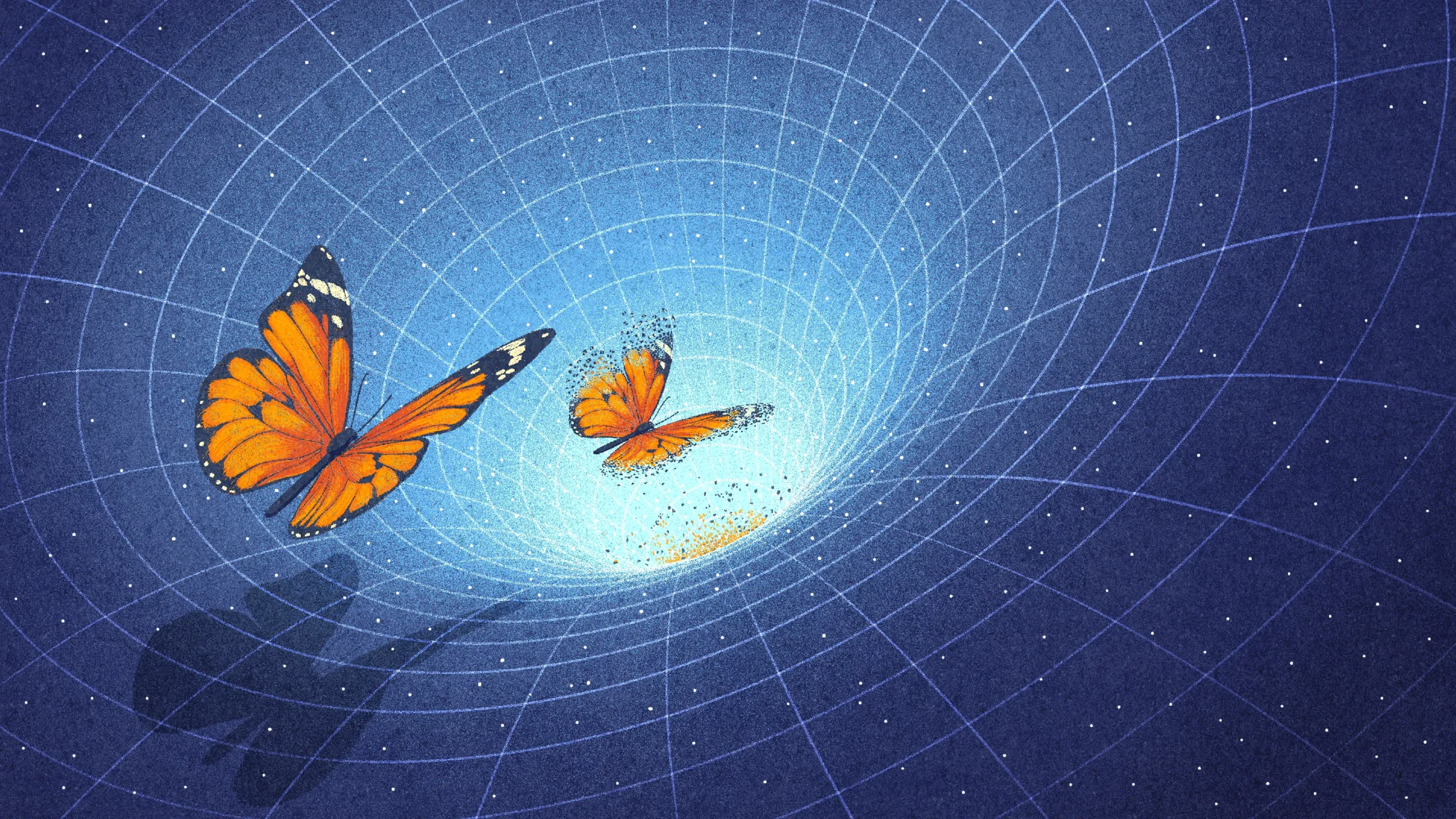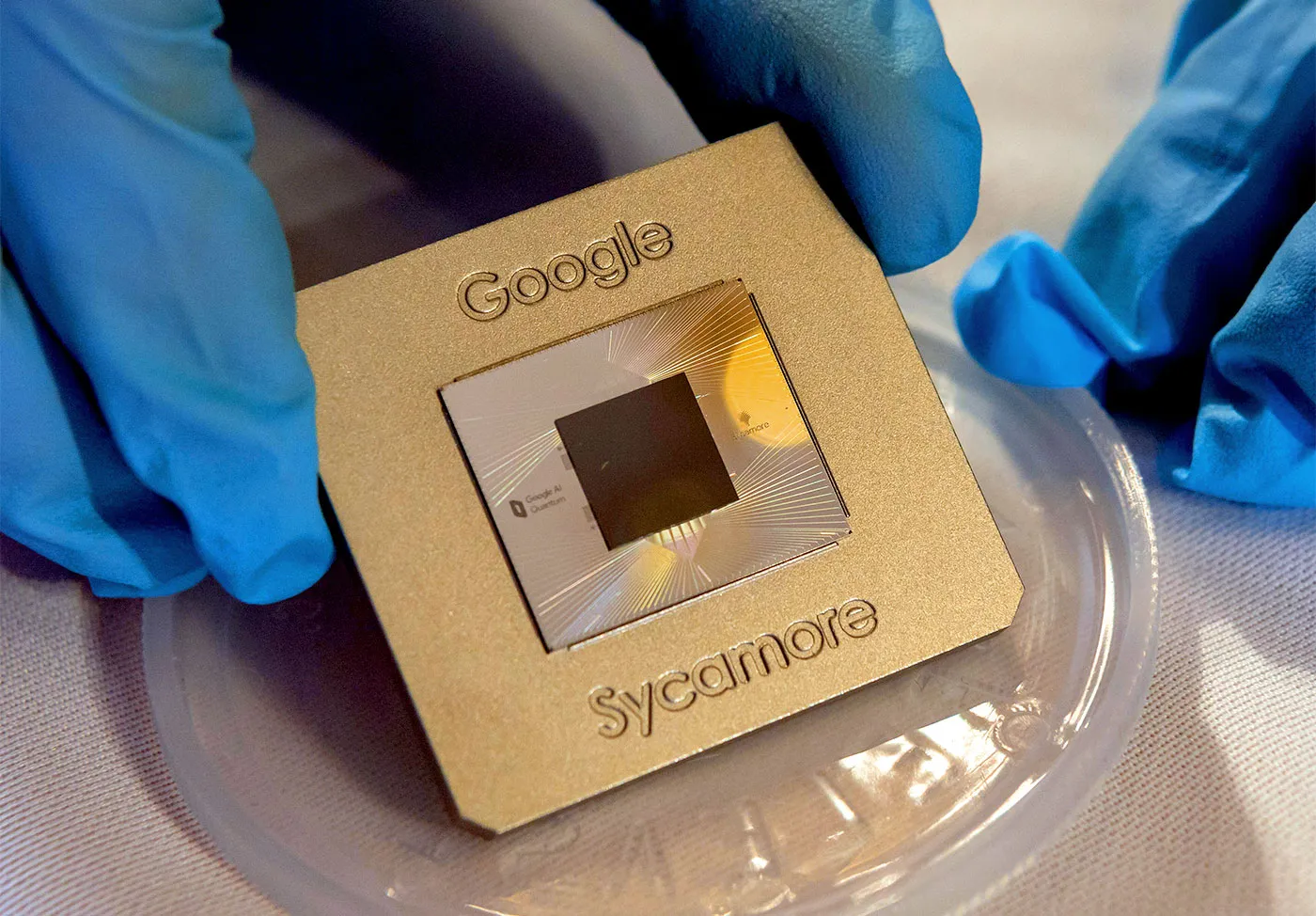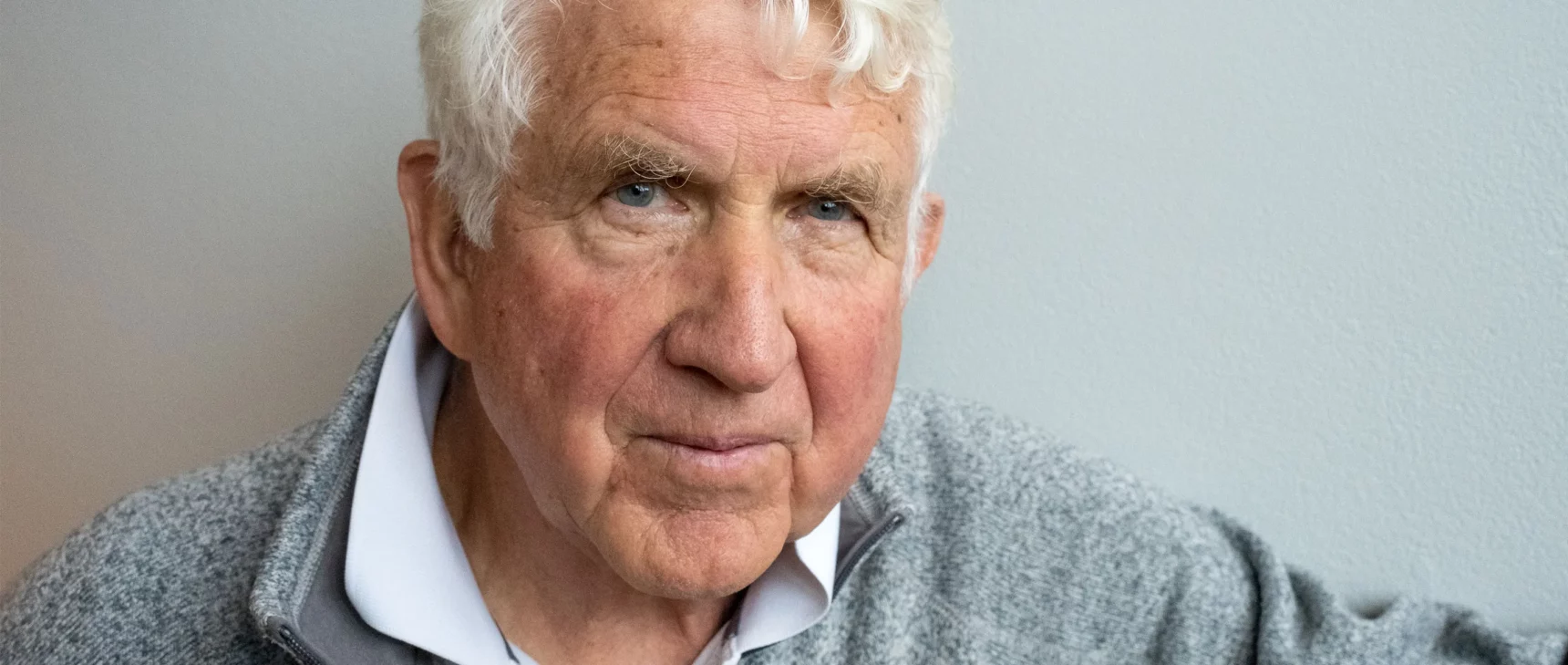Wormhole Experiment Called Into Question

A holographic wormhole would scramble information in one place and reassemble it in another. The process is not unlike watching a butterfly being torn apart by a hurricane in Houston, only to see an identical butterfly pop out of a typhoon in Tokyo.
Myriam Wares for Quanta Magazine
Introduction
In January 2022, a small team of physicists watched breathlessly as data streamed out of Google’s quantum computer, Sycamore. A sharp peak indicated that their experiment had succeeded. They had mixed one unit of quantum information into what amounted to a wispy cloud of particles and watched it emerge from a linked cloud. It was like seeing an egg scramble itself in one bowl and unscramble itself in another.
In several key ways, the event closely resembled a familiar movie scenario: a spacecraft enters one black hole — apparently going to its doom — only to pop out of another black hole somewhere else entirely. Wormholes, as these theoretical pathways are called, are a quintessentially gravitational phenomenon. There were theoretical reasons to believe that the qubit had traveled through a quantum system behaving exactly like a wormhole — a so-called holographic wormhole — and that’s what the researchers concluded. When it was published in November, the experiment graced the cover of Nature and was widely covered in the media, including in this magazine.
Now another group of physicists has analyzed the result and determined that, while the experiment may have produced something vaguely wormhole-like, it wasn’t really a holographic wormhole in any meaningful sense. In light of the new analysis, independent researchers are coming to doubt that the teleportation experiment has anything to do with gravity after all.
“I feel that the evidence for a gravitational interpretation is weakening,” said John Preskill, a theoretical physicist at the California Institute of Technology who was not involved with either study.
The group did teleport something on the Sycamore chip, however, and they did it in a way that — at least on the surface — looked more wormhole-like than anything produced by earlier experiments. The dispute over how to interpret the experiment springs from rapid developments involving holography, which functions as a sort of mathematical pair of 3D glasses that lets physicists view a quantum system as a gravitational one. Studying wormholes through the gravitational lens has uncovered new ways to teleport quantum information, raising hopes that such quantum experiments might someday go in the other direction and probe quantum gravity in the lab. But the wormhole brouhaha highlights the fact that determining when the holographic lens works — and therefore whether certain aspects of quantum gravity might be accessible on quantum computers — may require greater subtlety than physicists imagined.
When he read the new response, Vincent Su, a physicist at the University of California, Berkeley who studies wormhole-like teleportation and is not involved with either group, wondered, “Is quantum gravity in the lab dead?”
Scrambling Wormholes
Wormholes have long been a fixture of science fiction writers in need of a mechanism for quickly moving their characters across the vastness of space, but the wormholes that appeared in Einstein’s theory of gravity initially seemed extremely improbable, requiring tricky manipulations of space-time that inevitably led to time-travel paradoxes. That changed in 2016, when three physicists — Ping Gao and Daniel Jafferis at Harvard University and Aron Wall, then at the Institute for Advanced Study — found an unexpectedly simple and paradox-free way to prop open a wormhole with a shock wave of negative energy.
“It’s quite beautiful. It started the whole thinking in this direction,” said Hrant Gharibyan, a quantum physicist at Caltech. “There’s a narrow window that you can throw stuff from the left universe to the right.”
The foundation of the work was one of the hotter trends in modern physics, holography.
Holography involves the study of profound relationships known as dualities. On their face, dual systems look completely different. They have different parts and play by different rules. But if two systems are dual, every aspect of one system can be precisely related to an element of the other system. Electric fields are dual to magnetic fields, for instance. A major finding in modern physics is that dualities also seem to link certain gravitational systems to quantum systems.
We might consider a collection of interacting particles, for instance, entirely within the framework of quantum theory. Or, as if by popping on a pair of 3D glasses, we might see the collection of particles as a black hole governed by the rules of gravity. Physicists have spent decades developing mathematical “dictionaries” that let them translate quantum elements into gravitational elements and vice versa, effectively putting on and taking off the glasses. They watch how particles, black holes and wormholes transform as one switches between the two perspectives. Calculations that are hard to do from one perspective are often easier from the other. A major hope of the field is to develop the ability to access the still mysterious rules of quantum gravity by studying better-understood quantum theories.
But questions abound as to how far the glasses trick will hold. Does every conceivable quantum theory pop into a gravity theory when viewed holographically? Can physicists understand gravity in our universe by finding its better-behaved quantum twin? No one knows. But many theorists have dedicated their careers to exploring a few well-understood holographic pairs of theories and are constantly searching for new examples.
Gao, Jafferis and Wall had already suggested in 2016 that passing through a wormhole (a gravitational enterprise) might have a quantum interpretation without the 3D glasses: the teleportation of quantum information. A couple of years later, another team made their speculation concrete.
In 2019, Gharibyan and his collaborators translated traversable wormholes into quantum language, publishing a step-by-step recipe for a peculiar quantum experiment that showcases the essence of holography. With the 3D glasses on, you see a wormhole. An object enters one black hole, traverses a sort of space-time bridge, and exits the other black hole. Take the glasses off, however, and you see the dual quantum system. Two black holes become two gigantic clouds of particles. The space-time bridge becomes a quantum mechanical link known as entanglement. And the act of traveling through the wormhole becomes an event that appears quite surprising from the quantum perspective: A particle carrying a qubit, a unit of quantum information, enters one cloud and becomes scrambled beyond all recognition. The qubit unscrambles and exits the entangled cloud as another particle — a development as unexpected as watching a butterfly being torn apart by a hurricane in Houston, only to see an identical butterfly pop out of a typhoon in Tokyo.
“Naïvely you’d never guess,” Gharibyan said, “that you could scramble and unscramble very chaotically, and the information comes out.”
But viewed through a holographic lens, the proceedings make perfect sense. The entangled clouds of particles are not a literal wormhole in our universe. But they are dual to a wormhole, meaning that they have a matching behavior for anything a traversable wormhole can do — including transporting a qubit.
This is what the team announced in the November Nature paper. They simulated the behavior of two clouds of entangled particles in a quantum computer and performed a teleportation that captured the essential aspects of traversing a wormhole from the holographic perspective.
But that wasn’t the only way to interpret their experiment.
Not All That Teleports Is Gravity
Over the past few years, researchers made another surprising discovery. Although they had spotted the scrambling teleportation recipe while using the gravitational lens, gravity wasn’t always essential.
Gravity scrambles information in a very particular way. In fact, theorists have argued that black holes must be the most efficient scramblers in nature. But when Gharibyan and his colleagues used clouds of particles that scrambled by different quantum rules than gravity, they realized that the clouds could still teleport by scrambling, albeit less efficiently. And when they looked at the alternative clouds through a holographic lens, they saw nothing — no wormholes.
Gharibyan’s group and another team led by Norman Yao at Berkeley put everything together in a pair of simultaneous papers in 2021. (Yao has since moved to Harvard.)

Norman Yao, a physicist at Harvard University, led the team that poked holes in last year’s wormhole paper.
Noah Berger for UC Berkeley
These papers laid out some of the characteristics that seemed to distinguish gravitational teleportation from teleportation by more vanilla sorts of scrambling. In particular, they identified a feature of all quantum systems known as size winding, which can be linked holographically to the speed of a particle falling through the wormhole. When gravity was responsible for the scrambling, size winding had a particular mathematical property and was said to be “perfect” in the systems they studied. That gave the Nature team a specific signal to hunt for.
“What was predicted in these earlier papers was that size winding is a holographic signature, almost like a smoking gun,” Su said.
More Particles, More Problems
Last spring, while the Nature paper was going through the peer-review process, Su and his collaborators carried out a teleportation-by-scrambling experiment on two quantum computers, one operated by IBM and another by Quantinuum. They called their teleportation demo “wormhole-inspired,” since they knew their quantum model used one of the nongravitational scrambling recipes. At the time, they suspected that an experimental demonstration of true gravitational teleportation would take a decade or longer.
To understand why gravitational teleportation is so tough to pull off, it helps to keep in mind that these quantum computers don’t literally contain clouds of particles that scramble and unscramble information of their own accord. Instead, they contain qubits, which are objects that act like particles (qubits can be made from either literal atoms or artificial ones). When scientists program the computer, they tell it to make quantum changes to the qubits according to an energy equation called a Hamiltonian. The Hamiltonian describes how the qubits change from one moment to the next. Effectively, this equation lets them customize the laws of quantum physics for the qubits. As the computer runs, it carries out a sort of simulation of how real clouds of particles governed by those laws would act.
Here’s the rub: For a definitive showcase of gravitational teleportation, you need big clouds of particles. How big? The bigger the better. The theorists had done all the math in the context of essentially infinitely large clouds. For an experiment, researchers generally agree that 100 particles per cloud would suffice for indisputable wormhole-behavior to emerge.

Last year’s experiment was run on seven qubits of Google’s Sycamore quantum computing chip.
Peter Kneffel/dpa/Alamy Live News
Yet as the number of particles goes up, the size of the Hamiltonian explodes. If you’re modeling the particles using one of the more tractable models of gravity, called the SYK model, your Hamiltonian must reflect the fact that every member of a group of particles can directly influence every other member. The Hamiltonian for 100 densely linked particles is an equation with a staggering 3,921,225 terms. This is far beyond what today’s quantum computers can simulate with a few dozen qubits. Even if one were willing to settle for a fuzzy wormhole dual to clouds of just 20 particles, the Hamiltonian would go on for an overwhelming 4,845 terms. This hurdle was a key reason why Su’s group thought that a true wormhole simulation was a decade away.
Then last November, a team of researchers led by Jafferis, Joseph Lykken of the Fermi National Accelerator Laboratory and Maria Spiropulu of Caltech surprised the community by announcing that they had run a quantum experiment displaying perfect size winding — the key signature thought to establish the existence of a gravitational dual, and thus a wormhole — using just seven particles. Even more surprising, they were able to stuff the behavior of this seven-particle system into a Hamiltonian with only five terms.
A Holographic Wormhole on a Chip
The core of the group’s work was a novel way of pruning many of those particle-to-particle connections described by the unwieldy SYK Hamiltonian. Numerous physicists have “sparsified” the SYK model for a given cloud size by dropping random terms, finding that simpler versions can keep the holographic properties of the original Hamiltonian.
Instead of deleting connections at random, Jafferis and his collaborators thought to use machine learning to intelligently prune only the connections that don’t affect the cloud’s ability to teleport, a simplification strategy praised by other researchers.
“I thought it was actually very clever,” Gharibyan said. “The sparsification I thought was a very great insight.”
“It was a good idea,” Preskill said.
The researchers took aim at the 10-particle SYK model, which has a Hamiltonian of 210 terms. They simulated teleportation between clouds of 10 particles on a standard computer and designed a machine learning algorithm to simplify the Hamiltonian as much as possible without breaking its capacity to teleport. The algorithm returned an extremely sparse Hamiltonian measuring just five terms that captured teleportation between two seven-particle clouds. (The machine learning algorithm apparently decided that three of the particles weren’t meaningfully contributing to the process.) The equation was simple enough to run on Google’s Sycamore quantum processor, a notable achievement.
“It’s cool that they were able to run something on quantum hardware,” Su said.
The Sycamore experiment confirmed that the Hamiltonian could carry out the teleportation, just as it had been trained to. But what really excited researchers was the fact that this gang of qubits also displayed perfect size winding — the supposed signature of a gravitational dual. Somehow a toy model of a toy model of a toy model of gravity had managed to maintain the holographic essence of its grandparent model. The researchers appeared to have done the equivalent of boiling down a tornado to a handful of molecules, which, despite being largely unable to interact with each other, still manage to keep the characteristic funnel shape.
“They had actually a pretty nice way to measure the size winding as well,” Gharibyan said. “It was pretty exciting.”
Many in the field were struck by just how simple the toy model was. One group in particular —Yao and his Berkeley colleagues Bryce Kobrin and Thomas Schuster — started to dig into how such a simple model could possibly capture the unspeakable chaos of gravity.
Too Small to Scramble
On February 15, the trio posted the results of their investigation, which involved analyzing the mathematical properties and behavior of the Nature team’s simple Hamiltonian. It has not been peer-reviewed. Their main finding is that the simple model departs from its parent model of gravity in crucial ways. These differences, the group argues, imply that the signals the researchers considered hallmarks of gravity no longer apply, and because of this, the best description of what the Nature team saw is not gravitational teleportation.
The least gravitational thing about the simplified Hamiltonian is that, unlike in the original SYK model, the five terms are “fully commuting,” which means that they don’t have a certain kind of interdependence. Commutativity makes it much easier to simulate the clouds of particles, but it implies that the clouds can’t scramble chaotically. Since chaotic scrambling is considered a defining property of black holes and is an essential ingredient in gravitational teleportation, experts doubt that such a simple Hamiltonian could possibly capture complicated wormhole-like behavior. Put loosely, the system more closely resembles the gentle spiral of draining bathwater than it does the churning turbulence of Class V river rapids.

Maria Spiropulu, a physicist at the California Institute of Technology, was one of the leaders of last year’s wormhole experiment.
Bongani Mlambo for Quanta Magazine
The researchers also proposed a nongravitational explanation for the supposed signature of holography, perfect size winding. The five-term Hamiltonian does have it, but so do other random five-term, commuting Hamiltonians that they tested. Moreover, when they tried to bump up the number of particles while keeping the commuting property, the size winding signal should have strengthened. Instead, it disappeared. The physicists reached a conclusion that researchers had not previously grasped because no one had studied such simple models holographically: Many fully commuting, small Hamiltonians seem to have perfect size winding, even though these models don’t have gravitational duals. This finding implies that, in small systems, perfect size winding isn’t a sign of gravity. It’s just a side effect of the system being small.
Both groups declined to comment while they work out their differences through peer-reviewed publications. The Yao group has submitted their analysis to Nature, and the Jafferis, Lykken and Spiropulu group will likely have a chance to respond. But five independent experts familiar with holography consulted for this article agreed that the new analysis seriously challenges the experiment’s gravitational interpretation.
Holographic Dreams
The holographic future may not be here yet. But physicists in the field still believe it’s coming, and they say that they’re learning important lessons from the Sycamore experiment and the ensuing discussion.
First, they expect that showing successful gravitational teleportation won’t be as cut and dry as checking the box of perfect size winding. At the very least, future experiments will also need to prove that their models preserve the chaotic scrambling of gravity and pass other tests, as physicists will want to make sure they’re working with a real Category 5 qubit hurricane and not just a leaf blower. And getting closer to the ideal benchmark of triple-digit numbers of particles on each side will make a more convincing case that the experiment is working with billowing clouds and not questionably thin vapors.
No one expects today’s rudimentary quantum computers to be up to the challenge of the punishingly long Hamiltonians required to simulate the real deal. But now is the time to start chiseling away at them bit by bit, Gharibyan believes, in preparation for the arrival of more capable machines. He expects that some might try machine learning again, this time perhaps rewarding the algorithm when it returns chaotically scrambling, non-commuting Hamiltonians and penalizing it when it doesn’t. Of the resulting models, any that still have perfect size winding and pass other checks will become the benchmark models to drive the development of new quantum hardware.
If quantum computers grow while holographic Hamiltonians shrink, perhaps they will someday meet in the middle. Then physicists will be able to run experiments in the lab that reveal the incalculable behavior of their favorite models of quantum gravity.
“I’m optimistic about where this is going,” Gharibyan said.




